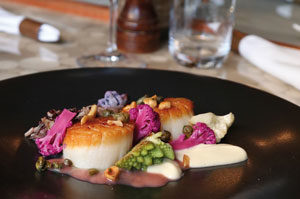December 2017 | view this story as a .pdf
Off-script moments in the kitchen reveal the culinary creativity of Maine’s award-winning chefs.
By Olivia Gunn Kotsishevskaya
 Your dish arrives, the components meticulously arranged and artfully drizzled. It’s a work of alchemy executed with obvious precision and insight, seemingly created from a tried-and-true method. And yet, more often than not–the secret ingredient? A touch of improvisation.
Your dish arrives, the components meticulously arranged and artfully drizzled. It’s a work of alchemy executed with obvious precision and insight, seemingly created from a tried-and-true method. And yet, more often than not–the secret ingredient? A touch of improvisation.
“We open at 4:30 p.m., and sometimes we’re printing the menu right then,” says Melody Wolfertz, owner and chef at Rockland’s In Good Company. Focusing on dishes that are “genuine and simple,” Wolfertz and her team rarely follow a recipe. “We just make it. If you have something here one night, it’s likely you’re never going to have it again,” she says. “We’re building on flavors, not following recipes.” Wolfertz says she thrives on adrenaline. “Yes, there are days when I wish it were a little more thought out, but I’d probably die of boredom if it were.”
Relying on her network of farmers and local foragers, Wolfertz doesn’t believe in over-complicating her dishes. “I refer to our food as ‘triage,’” she says. “I cook on three butane camp stoves. My food isn’t meant to be pretty. It isn’t meant to be structural.”
But Wolfertz doesn’t throw the rule book totally out of the window, particularly if she’s drawing from another culture’s recipes. “You can’t riff off another country until you know that country,” she says. “First you learn French, the classic techniques you’re trained in. From there you can start experimenting.” Wolfertz flexed her international culinary muscles during her ‘Food Journey’ dinner series earlier this year at In Good Company. The series covered a diverse geography of international cuisines, from Greenland, to Greece, to Gaza–faithfully reproducing traditional dishes in her Rockland kitchen.
But as for her daily menu? “That’s playtime. I have a firm belief that if you’re starting with the best ingredients, then it’s going to be good. How do you screw up something fantastic in its simplest form?”
Wolfertz’s musings bring to mind the words of the queen of kitchen improvisation, Ms. Julia Child: “In cooking, you’ve got to have a what-the-hell attitude.”
The Art of Spontaneity
Let’s say 20 pounds of matsutake mushrooms show up after an evening’s menu has already been laid out. What next? “I jumped to serve them that night,” Nate Nadeau, Fore Street’s Chef de Cuisine says. “They were the first of the season. We cleaned them up and made a compound butter. They’re really piney, so we used juniper and some sumac one of our foragers had brought in that day.”
Using ingredients caught, raised, grown, and foraged throughout Maine from the likes of Four Winds Farm in Lisbon, Nadeau and his line cooks are already working with the best paints on the palette, but what happens on the canvas each night is even more impressive. “We write our menu here every day,” he says. “That’s the function of our restaurant. Our crew is here every morning prepping from the ground up for that evening’s meals. We have an idea of what’s coming at us every night as far as proteins and produce, but it changes throughout the afternoon.” With ingredients arriving until the very last minute, the team at Fore Street has to be prepared for Nadeau’s last-minute decisions and inspirations. “The people who help us execute this have skills that you don’t necessarily learn in culinary school.”
Sizzling Improv
Working under pressure while staying innovative is bound to result in some off-script moments, so why not make a menu for them? The Chef’s Tasting Menu at Five Fifty-Five on Congress Street, owned by Steve and Michelle Corry, is the perfect outlet for that creative energy. “It allows us to have a little fun with some extra ingredients we have in-house–something cool we saw at the Farmer’s Market we can only get in smaller quantities,” says Chef Kyle Robinson. “We have quite a bit of fun with it.”
Looking at a collection of ingredients for tonight’s meal, Robinson envisions his tasting menu. “I’ll start the seven-course menu off with a scallop crudo with apple-and-cilantro aguachile, fennel, and chorizo oil, then a local chicken liver pâté with grape jam, fermented grapes, husk cherries, and house-made brioche.” And that’s just the beginning. A sweet potato agnolotti and butternut squash may make an appearance, along with seared scallops, cauliflower purée, roasted romanesco with a sauce of hazelnuts, capers, and red wine. To finish it all off? “A date cake with figs, mascarpone mousse, and tahini ice cream.” If one dish proves particularly popular, there’s a chance it’ll find a spot on the permanent menu.
Should guests request the Chef’s Tasting Menu, they should hang on for a delicious ride. “I’ll grab a purée from this dish, a vinaigrette from that dish, some vegetables from another entrée. It ends up being a collection of little bits and pieces of different menu items transformed into something new.” This spontaneity means you’re likely to see a dish once–and only once. “We don’t do the same thing over and over again. It tends to be similar people who come back for this experience, so we try to give them something they haven’t seen before,” Robinson says. “It’s great fun. On occasion, if it’s a crazy busy night, it can be a little difficult for us to stop and clear our heads and think, ‘What can we come up with right now?’ But on a mellow weeknight, it gives us a chance to be creative and try out something we’ve read about or seen.”
Happy Accidents
Some chefs find last-minute menu ventures exhilarating–others less so. “The thing is, I try not to have that happen,” says Adam Flood, Executive Chef at Grace. It’s stressful enough making sure the food ordered from the menu is perfect, let alone cooking off-the-cuff. That’s not to say he’s never been pushed to improvise.
“I’ve had a few happy accidents in the kitchen,” Flood says. “I remember making king oyster mushroom confit, which can be very rubbery if not treated right. I put them in the oven without checking the temperature, a very rookie thing to do, and cooked them at 350 degrees when it should have been 225. I left them in the oven at 350 for four hours.” After abandoning the effort to focus on other dishes at hand, Flood returned that evening to examine the aftermath. “They were super caramelized, nice and soft. They were the best mushrooms I ever had!”
Flood’s mushrooms ultimately made it onto Grace’s menu for a time as Fried King Oyster Mushrooms with black garlic aioli, though he says the process of improvisation in the kitchen is not one he enjoys. “When stuff like that happens, it feels like a horrible pit in your stomach. You want to puke, to be honest. But then you get away from that feeling, think of what you’ve done in the past, and move forward to fix it. I enjoy the art of perfection. If things aren’t going well and I’m pushed to improvise, I can and I’m good at it. But it’s only satisfying after the fact.”
There’s a romanticized image, one many of us share, of our favorite Maine chefs whisking, sautéing, and chopping their way to the next signature dish led by pure imagination and instinct. But maybe we value equally, if not more than their artistry, their resourcefulness.






0 Comments